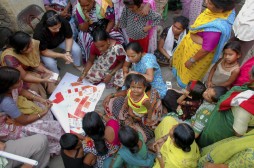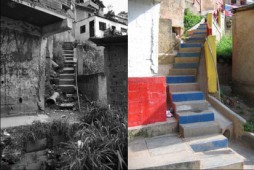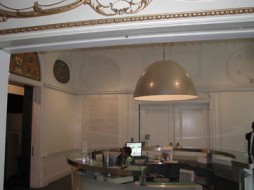From the Secretary: A Grand Design
Just weeks ago, the global population hit seven billion. Half of us live in urban areas, many in emerging and developing economies. Considering all the challenges this expanding population presents–crumbling infrastructure, overloaded transportation systems, lack of adequate housing and potable water–coming up with solutions is more important than ever. An essential component to solving these problems will be innovative design.

Shack/Slum Dwellers International. Yerwada Slum Upgrading Project. Yerwada slum, Pune, India, 2008-present. Photo: © SDI
In 1996, Steve Jobs remarked, “Design is a funny word. Some people think design means how it looks. But of course, if you dig deeper, it’s really how it works.” Fifteen years later, as the magnitude of the world’s challenges has increased, so has the importance of design. The Smithsonian is helping to lead the way in celebrating and supporting the people who are exploring ways to make things work better. We recognize the need to redesign our own systems and facilities, too–to be more energy-efficient, more sustainable, and more adaptive to the needs of the modern world. Who better to set the pace than our own Cooper-Hewitt, National Design Museum in New York City?
Starting with ourselves
Located in the historic Carnegie Mansion, Cooper-Hewitt is implementing RE:DESIGN, a transformative expansion that will both restore the museum to its original 19th century splendor and inspire future waves of designers with a vision of the 21st century and beyond. The first floor of the building will be turned into a permanent exhibition celebrating design and explaining its vital role, using informative pieces from the museum’s collection and loan items. The second floor will convert offices into a swath of continuous gallery space to display more of the collection and exhibit temporary shows. The third floor will represent the future of Cooper-Hewitt with a gallery spanning the entire length of the building that will accommodate some of the largest examples of influential, cutting-edge, contemporary designs.
Not merely a renovation of the mansion itself, RE:DESIGN will also improve Cooper-Hewitt’s educational outreach via new media tools, create a new national design library at the townhouses on East 90th Street, and fortify the museum’s endowment. These steps will cement Cooper-Hewitt’s place as a truly dynamic national design museum, reflecting the increasing importance of design. Cooper-Hewitt will reopen in fall 2013, a rejuvenated and radiant example of design excellence.
Design Across the Smithsonian
As part of the grand reopening, the museum will feature Tools: Design Across the Smithsonian, a major exhibition drawing from collections throughout the Smithsonian to advance the public’s understanding of design. For example, ancient tools from the collection at the National Museum of Natural History are among the very first examples of human design and extend both our analytical and exploratory capabilities. What must be taken into consideration when designing for extremes in space? We can find out by examining materials, spacesuits and aircraft from the National Air and Space Museum. How does climate change drive engineers and designers to develop products that help solve environmental problems? Find out what role Smithsonian scientists who study these critical issues have played. In what ways has design evolved throughout history? Check out objects from Smithsonian museums and scientific research centers to see the technological and social changes that have guided designers through the years.
Design lives at the crossroads of science, technology and the visual arts. This exhibition will explore how design thinking has shaped our world in the past and how it can shape a better future.
Design with the Other 90%: CITIES

Integral Urban Project. San Rafael-Barrio Unido sector in La Vega settlement, Caracas, Venezuela, 1999-present. Photo: © PROYECTOS ARQUI 5 C.A.
One doesn’t have to wait for the future or even the grand reopening of the National Design Museum to experience some of the worthwhile and innovative design around the world. The Cooper-Hewitt exhibition, Design with the Other 90%: CITIES, is on display at United Nations headquarters in Manhattan through Jan. 2012. Globally, nearly one billion people live in “informal settlements”–commonly known as slums–and that population is projected to balloon to two billion by 2030. This exhibition shows how innovative design can tackle the immense problems caused by uncontrolled growth. But more than that, Cooper-Hewitt will foster dialogue between designers, communities and other stakeholders by sharing information collected in the field through an online open-network database aptly named Design Other 90 Network.

Kibera Public Space Projects. Former dumping site on border of Soweto East and Silanga Villages in Kibera informal settlement, Nairobi, Kenya, 2006-10. Photo: © Kounkuey Design Initiative
Design with the Other 90%: CITIES is divided into six parts: Exchange focuses on partnerships that share knowledge to come up with innovative solutions; Reveal exposes the depth of problems in these often overlooked settlements; Adapt highlights the design challenges inherent in local climates, topographies and urban landscapes; Include features designs that engage and strengthen marginalized populations and communities; Prosper highlights projects that have evolved to meet the needs of people who migrate to urban areas in search of work and a better life; and Access showcases design solutions to the most needed basics found lacking in informal settlements: food security, water, sanitation, electricity, health, education and transportation. The impressive breadth and reach of these programs speak to the collaboration, creativity and dedication of local communities working with designers to make a difference.
A lasting design
Don Meeker, an environmental graphic designer responsible for improving the safety of waterway and road signs by making them more visible, once said, “I’ve always thought that design can be a form of social activism.” The designers and innovators featured by Cooper-Hewitt represent the best of this spirit, applying their talents to meet humanity’s most pressing needs. The 2013 unveiling of the redesigned Cooper-Hewitt National Design Museum will be an enduring monument to this spirit, and I hope all of you get a chance to visit.
Posted: 18 November 2011
- Categories:











